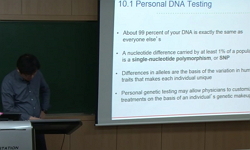<P>Polyunsaturated fatty acids usually undergo lipid peroxidation induced by reactive oxygen species (ROS). Calcium-independent cellular phospholipase A(2) (iPLA(2)) can maintain fatty acid compositions in phospholipids depending on physiologica...
http://chineseinput.net/에서 pinyin(병음)방식으로 중국어를 변환할 수 있습니다.
변환된 중국어를 복사하여 사용하시면 됩니다.
- 中文 을 입력하시려면 zhongwen을 입력하시고 space를누르시면됩니다.
- 北京 을 입력하시려면 beijing을 입력하시고 space를 누르시면 됩니다.


Chlorine dioxide enhances lipid peroxidation through inhibiting calcium-independent cellular PLA<sub>2</sub> in larvae of the Indianmeal moth, <i>Plodia interpunctella</i>
한글로보기https://www.riss.kr/link?id=A107736872
- 저자
- 발행기관
- 학술지명
- 권호사항
-
발행연도
2017
-
작성언어
-
- 주제어
-
등재정보
SCOPUS,SCIE
-
자료형태
학술저널
-
수록면
48-56(9쪽)
- 제공처
-
0
상세조회 -
0
다운로드
부가정보
다국어 초록 (Multilingual Abstract)
<P>Polyunsaturated fatty acids usually undergo lipid peroxidation induced by reactive oxygen species (ROS). Calcium-independent cellular phospholipase A(2) (iPLA(2)) can maintain fatty acid compositions in phospholipids depending on physiological conditions. An insect iPLA(2) (Pi-iPLA(2)) was predicted from the transciptome of the Indianmeal moth, Plodia interpunctella. It encodes 835 amino acids. It possesses five ankyrin repeats in the N terminal and patatin lipase domain in the C terminal. Pi-iPLA(2) was expressed in all developmental stages of the Indianmeal moth. In the larval stage, it was expressed in all tissues tested. RNA interference (RNAi) specific to Pi-iPLA(2) was performed using specific double-stranded RNA (dsRNA). It resulted in almost 70% of reduction in gene expression. Under such RNAi condition, P. interpunctella exhibited significant accumulation of lipid per oxidation based on the amount of malondialdehyde. RNAi of Pi-PLA(2) expression also impaired cellular immune response of P. interpunctella. Chlorine dioxide (ClO2), an insecticidal agent by generating ROS, increased lipid peroxidation in a dose-dependent manner. However, the addition of vitamin E (an antioxidant) reduced the formation of lipid peroxidation. ClO2 treatment significantly reduced expression of Pi-iPLA(2) but increased lipid peroxidation in larval fat body of P. interpunctella. Furthermore, larvae treated with dsRNA specific to Pi-iPLA(2) were significantly susceptible to ClO2 treatment. These results suggest that Pi-iPLA(2) plays a crucial role in repairing damaged fatty acids from phospholipids. Our results also suggest that ClO2 can elevate lipid peroxidation through inhibiting Pi-iPLA(2) expression in addition to direct ROS production.</P>




 ScienceON
ScienceON






